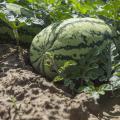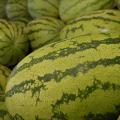What should be the plant spacing for cucurbits?
Watermelon plants should have about 25 square feet per plant. If you are planting on 8 foot rows, the plants should be about 3 feet apart. If you are planting on 6 foot rows, the plants should be about 4 feet apart. Cantaloupes need about 20 square feet per plant, and cucumbers should have about 6 square feet per plant. Arrange the plants to fit your equipment and situation.
News
RAYMOND, Miss. -- Commercial vegetable growers have a new mobile-based resource to help them manage pests and diseases in their crops. The MyIPM for Vegetables app is the latest in the MyIPM app series. MyIPM for Vegetables currently offers resources for tomatoes and cucurbits, which includes cucumbers, pumpkins, squash and watermelons.
RAYMOND, Miss. -- Harvest is in full swing for Mississippi watermelon producers as rains ramp up, increasing the likelihood of disease and ruined melons.
RAYMOND, Miss. -- Watermelon production in Mississippi is off to a good start in the early days of harvest season. “Right now, everything looks really good,” said Heath Steede, Mississippi State University Extension agent in George County. “They’re pulling them pretty hot and heavy right now.”




